First of all, we are again having some problems posting photos from China, so if you can't see the photos in the post below you should be able to see them at: http://www.flickr.com/photos/43083052@N07/sets/72157622553601190. If you can see them below, don't worry about it as they are the same photos! With that out of the way, here we go....
After a few days in Chengdu we were glad to get back on the road again. Matter of fact, it had been a good, long while since we'd had a long stretch on the bikes, having taken a train from Ulaanbaatar to Datong, China followed by about 6 days of cycling before Mike's derailer broke, followed by a long stay in Beijing, a two-day train to Chengdu and a few days hanging out in Chengdu. The day before we left Chengdu we met up with an Italian and an Argentinian in an outdoor goods store, who were also heading out to cycle Sichuan and Yunnan. At some point in our chat, we said we were really excited to get back on the road, and so sick of loading the bike up in trains and vans, etc... so, we were really going to try NOT to travel any way other than on our bikes for the rest of our time. Having been on the road a little longer than us, they chuckled knowingly and said..."Yeah, we say that all the time too. But shit always seems to happen, ya know?" Little did we know we'd learn our lesson, and soon.
But first we delayed our stay to do some route planning we had neglected and see the famous Chengdu pandas. It was a little panda-crazy and an uber-touristy type of activity, but they were super cute and we enjoyed ourselves.
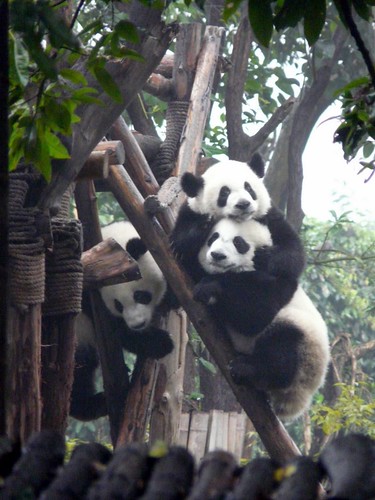
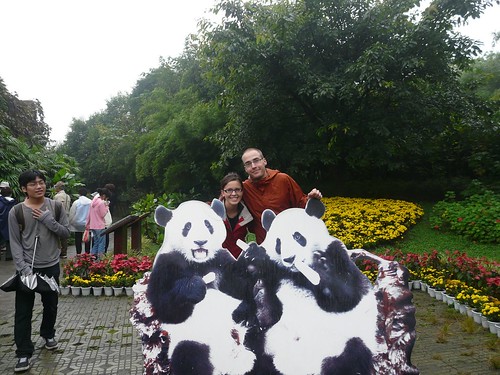
That night we had our final meal in Chengdu, going to a restauant recommended to us by a man from Chengdu we rode the train with on our trip from Beijing. We tried a little bit of about 20 different Sichuan dishes.... yummm
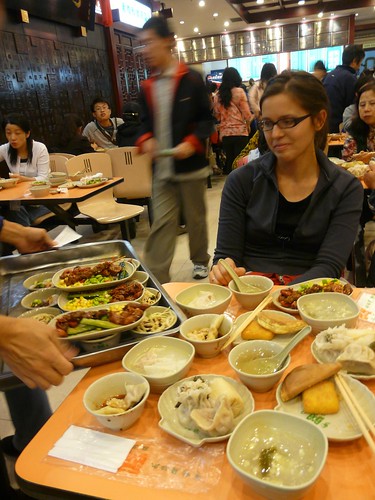
The next day we made our way out of town. After about 10km of craziness and another 20km of smoggy Chengdu suburbs bursting with construction, we were finally on a beautiful, wide, fairly quiet highway. That night we stayed in a town 62km from Chengdu called Dujiangyan. The main feature of the town was an irrigation project built in 256 B.C., chiefly responsible for the tremendous fertility of Sichuan - it is China's fresh produce basket and as a result has always been one of the most prosperous provinces in China. Our friend and construction management professor from Chengdu (that we met on the train) said he thought this project was a much more impressive feat of engineering than the Great Wall. This made us laugh, as the whole time we visited the Great Wall Mike couldn't help mentioning (about 1000 times) that it's impressive and all, but would it really have stopped anyone from invading?? (More than the equally high mountains surrounding it, at least?) We concluded it was likely just fantastic foresight at the tourism revenues the wall could generate that were the key driver of the project. Anyway, given that the dyke is still very successful at diverting water to irrigation channels across the province, and the fact that it was built so many years ago without the benefit of dynamite (they apparently heated the rock up with fire and then cracked it with cold water instead), I think we agreed with the professor's assessment.
Below is Mike in one of the rivers created in 256B.C. by breaking the rocks with fire and cold water.
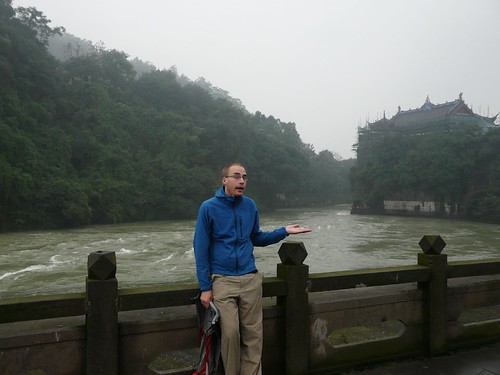
This is the water break at the start of the system which pushes 60% of the water into the irrigation system.
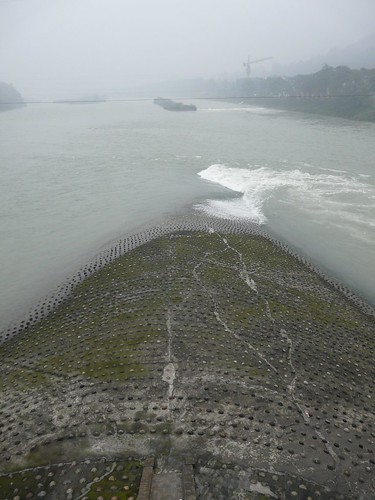
The town of Dujiangyan turned out to be very lovely and seemed quite rich. There was a fantastic little alley of restaurants along the river where you could see your meal squawk or swim or grow in front of you (whatever the case may be) and a charming little downtown that, besides the red lanterns hanging in the trees, had a very Parisian feel with the open air cafes and high-end clothing shops.
They had every type of live food you could want...rabbits, game bird, chickes and seafood galore..

This small city felt kind of European at times...

The next day we set out for what we knew would be a more rugged destination. We planned to visit Yingxiu, the epicenter of last year's big earthquake (read more here) for a late lunch and stay overnite in neighbouring Gengda, where we knew there was a hotel. We slept in quite late and got a late start at 11am, but seeing as we only had 70 km to travel we didn't think we'd have any problem finishing up in the daylight.
The morning's ride was slow, due to significant amounts of construction as well as a few tunnels where we had to stop and mount our lights, but it was absolutely beautiful. We started in a bit of a drizzle which turned into just a heavy mist as we rode on, which gave everything an even more mysterious air to it.
Below are a bunch of photos of the views as we cycled to Yingxiu.

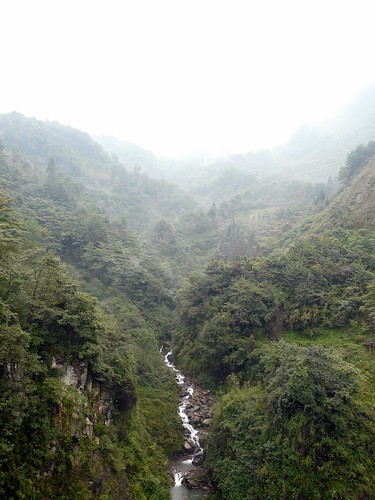


This should maybe have tipped us off as to what was to come...
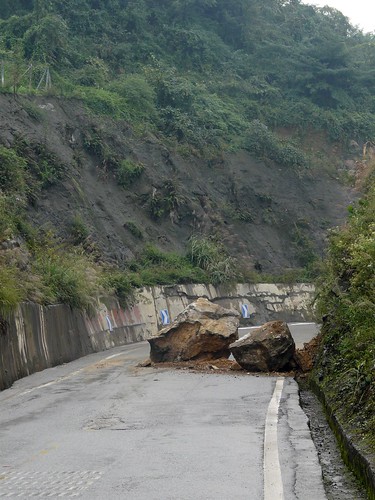
Below are two rivers joining, one from down the mountain and the other passed by a plant of some type (cement I think?)...
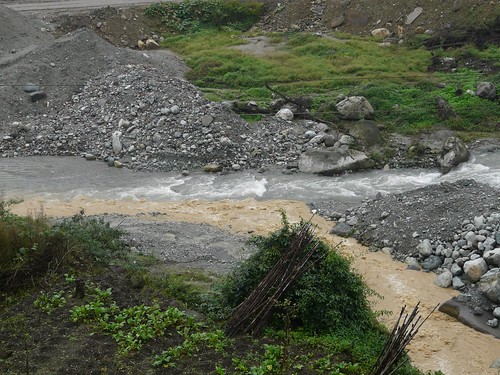
We arrived in Yingxiu as planned for a late lunch, and paid a whopping 6 Yuan each ($1CDN) for a huge bowl of the best spicy noodle soup we've had so far in China. The town was quite a sight. It is absolutely amazing and sad to see what a devastating effect mother nature can have... they've left a torn-up highway and broken-down middle school as memorials, while the rest of town is still under heavy construction.
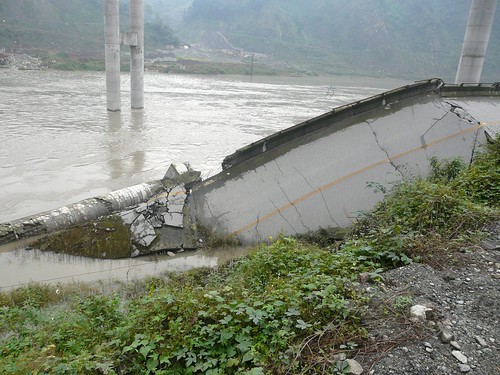
Below is a picture of Jen beside a fallen piece of highway from the earthquake last year (a 5.13!) and reconstruction from this was still VERY much underway. It was actually amazing how many people in the area were still living there even though the area was very hard to get to with the lack roads and infrastructure.
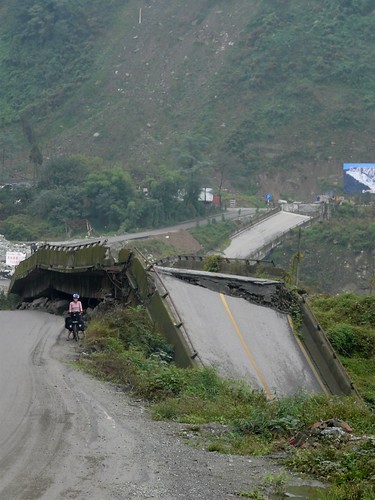
We set off for the remaining 25km to Gengda after lunch, quite certain we could make it there before dark, despite the fact it was all uphill. Unfortunately, we didn't realize that it was all uphill AND under the heaviest construction we'd seen so far AND ridiculously muddy and wet. We had a hard enough time just staying upright for the first 3 km or so and the math didn't look very good for getting to Gengda before dark, so we hitched a ride with a couple half-empty vans travelling to Gengda together.
The road into Ganda.
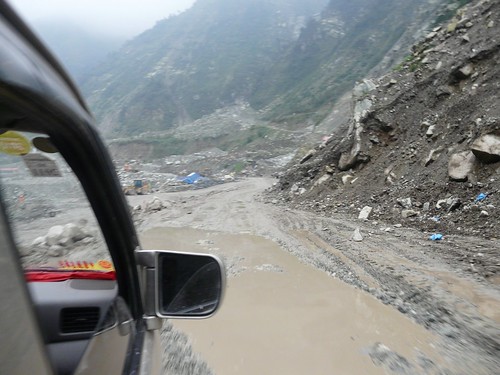
Thank goodness we did. The road got much worse after that and stayed that way all the way to Gengda, so we would have otherwise been stuck pitching our tent at a construction site on the side of the very rock-crowded road... not our favorite option.
This is a collapsed tunnel that was part of the highway before it was destroyed. There were at least 4 that we passed that had collapsed and some were in the process of being rebuilt.
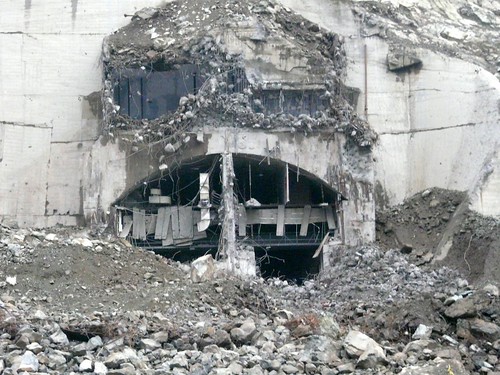
This dam had obviously broke in the earthquake and had contributed to some of the destruction we saw. Also it made reconstruction more difficult and the make-shift road was often level with the raging river.

This house that we cycled by was one of many casualties of the broken dam and earthquake.
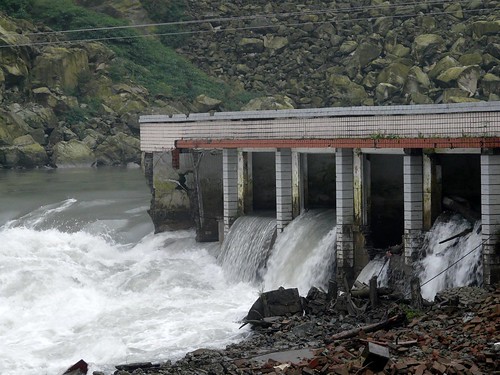
But the intrigue wasn't over. The whole way there, I chatted with the folks we were travelling with, trying to get an idea of how the road was after Gengda. It was very clear that the road was back to the great, smooth pavement we were used to in China after Wolong, a city about 25 km after Gengda, but I couldn't figure out what they were saying about the road to Wolong. I told Mike, "It seems like they're saying the first 10 km are good, but then it's bad... so bad that cars can't go, not even bikes... and then something about our backs? But that CAN'T be right...I must be understanding something wrong here..." We just couldn't imagine anything that wouldn't be passable with a car, but that they would think we should still cross? Luckily one of the very helpful van drivers let us unload our stuff into the hotel and then drove us off along the road towards Wolong to take a look.
Turns out we understood exactly right... never woulda thought! Smack dab halfway on the road to Wolong was a huge landslide, rocks still falling and all, barring the only highway between the two towns. Right beside it over the white-water rapids was a bridge (or a single log, I should say) that would allow for people to walk very carefully, one at a time, followed by a 4 km path 1000m up a cliff before reaching the highway on the other side. This was the only path to Wolong, which some helpful young Chinese dudes also stranded by the landslide offered to help us cross by foot with all our gear (2 bikes and 10 bags) for about $300. Though oh so slightly tempted, we decided firmly against it... after seeing the devastation along the road that we drove through, it didn't feel like the best idea to venture into the unstable and unknown rocky wilderness. So we were at a dead end...
I took this picture standing on the road we were cycling on. The road should have continued into the background of the picture just above the river, but as you can see it is completely covered by a rock-slide which occurred about a month earlier. Even as we were standing there rocks continued to fall down the mountain and into the river.

You can see a small bridge spanning the river (it is really more of a log than a bridge). We were told that the only route to Danba was to cross this "bridge", climb the cliff on the other side and hike through the forest for 4km to get back on the road on the other side of the slide
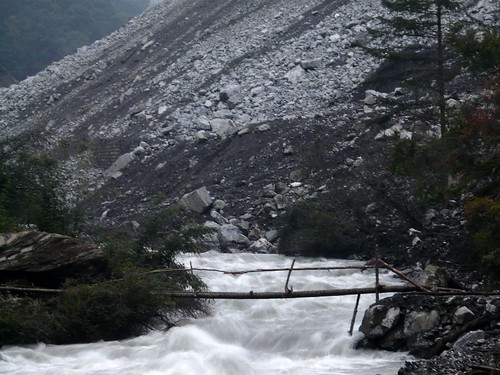
The combination of the road construction crews clearing boulders off the make-shift road, and the falling rocks themselves did not make a return trip on the road seem very fun or safe, so we got the driver to take us back to Dujingyan the next morning where we could plan an alternate route.
One of the many road crews working hard to clear the road as they slowly rebuild it.

Another crew securing the side of the mountain from rock slides.

So here we are, back in Dujiangyan, having checked in to our hotel only 24 hours and 20 minutes after we checked out the day before. We're doing some research on the alternate routes: one which is significantly longer but would end us up at the same destination we had planned for the end of our first week cycling, and the other along a more travelled stretch with more tourist sights but more cars. Either way, they both look beautiful and landslide-free, which is a plus. Stay tuned!
But first we delayed our stay to do some route planning we had neglected and see the famous Chengdu pandas. It was a little panda-crazy and an uber-touristy type of activity, but they were super cute and we enjoyed ourselves.


That night we had our final meal in Chengdu, going to a restauant recommended to us by a man from Chengdu we rode the train with on our trip from Beijing. We tried a little bit of about 20 different Sichuan dishes.... yummm

The next day we made our way out of town. After about 10km of craziness and another 20km of smoggy Chengdu suburbs bursting with construction, we were finally on a beautiful, wide, fairly quiet highway. That night we stayed in a town 62km from Chengdu called Dujiangyan. The main feature of the town was an irrigation project built in 256 B.C., chiefly responsible for the tremendous fertility of Sichuan - it is China's fresh produce basket and as a result has always been one of the most prosperous provinces in China. Our friend and construction management professor from Chengdu (that we met on the train) said he thought this project was a much more impressive feat of engineering than the Great Wall. This made us laugh, as the whole time we visited the Great Wall Mike couldn't help mentioning (about 1000 times) that it's impressive and all, but would it really have stopped anyone from invading?? (More than the equally high mountains surrounding it, at least?) We concluded it was likely just fantastic foresight at the tourism revenues the wall could generate that were the key driver of the project. Anyway, given that the dyke is still very successful at diverting water to irrigation channels across the province, and the fact that it was built so many years ago without the benefit of dynamite (they apparently heated the rock up with fire and then cracked it with cold water instead), I think we agreed with the professor's assessment.
Below is Mike in one of the rivers created in 256B.C. by breaking the rocks with fire and cold water.

This is the water break at the start of the system which pushes 60% of the water into the irrigation system.

The town of Dujiangyan turned out to be very lovely and seemed quite rich. There was a fantastic little alley of restaurants along the river where you could see your meal squawk or swim or grow in front of you (whatever the case may be) and a charming little downtown that, besides the red lanterns hanging in the trees, had a very Parisian feel with the open air cafes and high-end clothing shops.
They had every type of live food you could want...rabbits, game bird, chickes and seafood galore..

This small city felt kind of European at times...

The next day we set out for what we knew would be a more rugged destination. We planned to visit Yingxiu, the epicenter of last year's big earthquake (read more here) for a late lunch and stay overnite in neighbouring Gengda, where we knew there was a hotel. We slept in quite late and got a late start at 11am, but seeing as we only had 70 km to travel we didn't think we'd have any problem finishing up in the daylight.
The morning's ride was slow, due to significant amounts of construction as well as a few tunnels where we had to stop and mount our lights, but it was absolutely beautiful. We started in a bit of a drizzle which turned into just a heavy mist as we rode on, which gave everything an even more mysterious air to it.
Below are a bunch of photos of the views as we cycled to Yingxiu.




This should maybe have tipped us off as to what was to come...

Below are two rivers joining, one from down the mountain and the other passed by a plant of some type (cement I think?)...

We arrived in Yingxiu as planned for a late lunch, and paid a whopping 6 Yuan each ($1CDN) for a huge bowl of the best spicy noodle soup we've had so far in China. The town was quite a sight. It is absolutely amazing and sad to see what a devastating effect mother nature can have... they've left a torn-up highway and broken-down middle school as memorials, while the rest of town is still under heavy construction.

Below is a picture of Jen beside a fallen piece of highway from the earthquake last year (a 5.13!) and reconstruction from this was still VERY much underway. It was actually amazing how many people in the area were still living there even though the area was very hard to get to with the lack roads and infrastructure.

We set off for the remaining 25km to Gengda after lunch, quite certain we could make it there before dark, despite the fact it was all uphill. Unfortunately, we didn't realize that it was all uphill AND under the heaviest construction we'd seen so far AND ridiculously muddy and wet. We had a hard enough time just staying upright for the first 3 km or so and the math didn't look very good for getting to Gengda before dark, so we hitched a ride with a couple half-empty vans travelling to Gengda together.
The road into Ganda.

Thank goodness we did. The road got much worse after that and stayed that way all the way to Gengda, so we would have otherwise been stuck pitching our tent at a construction site on the side of the very rock-crowded road... not our favorite option.
This is a collapsed tunnel that was part of the highway before it was destroyed. There were at least 4 that we passed that had collapsed and some were in the process of being rebuilt.

This dam had obviously broke in the earthquake and had contributed to some of the destruction we saw. Also it made reconstruction more difficult and the make-shift road was often level with the raging river.

This house that we cycled by was one of many casualties of the broken dam and earthquake.

But the intrigue wasn't over. The whole way there, I chatted with the folks we were travelling with, trying to get an idea of how the road was after Gengda. It was very clear that the road was back to the great, smooth pavement we were used to in China after Wolong, a city about 25 km after Gengda, but I couldn't figure out what they were saying about the road to Wolong. I told Mike, "It seems like they're saying the first 10 km are good, but then it's bad... so bad that cars can't go, not even bikes... and then something about our backs? But that CAN'T be right...I must be understanding something wrong here..." We just couldn't imagine anything that wouldn't be passable with a car, but that they would think we should still cross? Luckily one of the very helpful van drivers let us unload our stuff into the hotel and then drove us off along the road towards Wolong to take a look.
Turns out we understood exactly right... never woulda thought! Smack dab halfway on the road to Wolong was a huge landslide, rocks still falling and all, barring the only highway between the two towns. Right beside it over the white-water rapids was a bridge (or a single log, I should say) that would allow for people to walk very carefully, one at a time, followed by a 4 km path 1000m up a cliff before reaching the highway on the other side. This was the only path to Wolong, which some helpful young Chinese dudes also stranded by the landslide offered to help us cross by foot with all our gear (2 bikes and 10 bags) for about $300. Though oh so slightly tempted, we decided firmly against it... after seeing the devastation along the road that we drove through, it didn't feel like the best idea to venture into the unstable and unknown rocky wilderness. So we were at a dead end...
I took this picture standing on the road we were cycling on. The road should have continued into the background of the picture just above the river, but as you can see it is completely covered by a rock-slide which occurred about a month earlier. Even as we were standing there rocks continued to fall down the mountain and into the river.

You can see a small bridge spanning the river (it is really more of a log than a bridge). We were told that the only route to Danba was to cross this "bridge", climb the cliff on the other side and hike through the forest for 4km to get back on the road on the other side of the slide

The combination of the road construction crews clearing boulders off the make-shift road, and the falling rocks themselves did not make a return trip on the road seem very fun or safe, so we got the driver to take us back to Dujingyan the next morning where we could plan an alternate route.
One of the many road crews working hard to clear the road as they slowly rebuild it.

Another crew securing the side of the mountain from rock slides.

So here we are, back in Dujiangyan, having checked in to our hotel only 24 hours and 20 minutes after we checked out the day before. We're doing some research on the alternate routes: one which is significantly longer but would end us up at the same destination we had planned for the end of our first week cycling, and the other along a more travelled stretch with more tourist sights but more cars. Either way, they both look beautiful and landslide-free, which is a plus. Stay tuned!



No comments:
Post a Comment